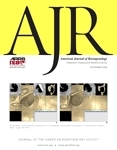by
Barbara Kram, Editor | November 05, 2008

American Journal
of Roentgenology
A new model that would allow interventional radiologists (radiologists who specialize in fine needle aspiration, fine needle biopsy and radiofrequency ablation) to better estimate patient radiation skin doses during CT guided interventional procedures has been developed according to a study performed at the Agios Savvas and Konstantopoulio Hospitals in Athens, Greece.
"It is clear that skin doses in CT guided interventional procedures can become very high. Even for skin doses around 1 Gy, the prospect of repeating a procedure makes the determination of peak skin dose crucial for avoiding radiation injuries," said Ioannis A. Tsalafoutas, PhD, Virginia Tsapaki, PhD, Charikleia Triantopoulou, MD, John Papailiou MD, Christina Pouli, MD, Virginia Kouridou, MSc, and Ioanna Fagadaki, MD, authors of the study.
The theoretical model that was developed "considers the skin dose resulting from each CT slice, utilizing data that is already stored along with CT images. The skin doses calculated with this model were compared with those measured using films positioned under patients that underwent CT guided interventional procedures. The results indicate that peak skin doses can be estimated accurately using the new theoretical model that provides a base for skin dose estimation in real time," said Dr. Tsalafoutas and colleagues.



Ad Statistics
Times Displayed: 109208
Times Visited: 6638 MIT labs, experts in Multi-Vendor component level repair of: MRI Coils, RF amplifiers, Gradient Amplifiers Contrast Media Injectors. System repairs, sub-assembly repairs, component level repairs, refurbish/calibrate. info@mitlabsusa.com/+1 (305) 470-8013
"It is important for CT interventional radiologists to be able to monitor the radiation skin dose to their patient and optimize their techniques, so as to avoid skin injuries and minimize the probability of radiation induced carcinogenesis. The first step toward this goal is to understand the risk, to quantify it and to identify factors that affect it in order to be able to reduce it," said Dr. Tsalafoutas and colleagues.
The theoretical method developed by Dr. Tsalafoutas and his colleagues could possibly lead to the development of specialized software for skin estimation in real time which "would be a significant technological advancement from the aspect of radiation protection," said Dr. Tsalafoutas and colleagues.
This study appears in the November issue of the American Journal of Roentgenology.
Go here for abstract:
http://www.ajronline.org/cgi/content/abstract/191/5/1601
About ARRS
The American Roentgen Ray Society (ARRS) was founded in 1900 and is the oldest radiology society in the United States. Its monthly journal, the American Journal of Roentgenology, began publication in 1906. Radiologists from all over the world attend the ARRS annual meeting to participate in instructional courses, scientific paper presentations and scientific and commercial exhibits related to the field of radiology. The Society is named after the first Nobel Laureate in Physics, Wilhelm Röentgen, who discovered the x-ray in 1895.
Back to HCB News

